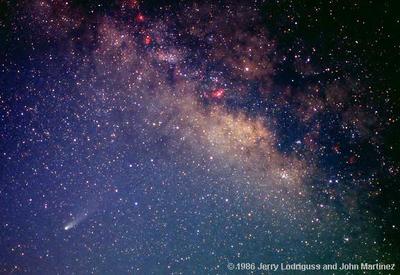Only once in every 76 years ...
The first record of it dates as far back as 249 B.C., documented by the Chinese as "a broom star".
Perhaps the most famous of all comets, Halley's Comet was named after the Sir Edmund Halley (October 29, 1656 – January 14, 1742) he was the English astronomer who "discovered" that it is the very same comet that comes back every 76 years, i.e. it orbits our sun every 76 years. Unfortunately, Halley died in 1742, never lived to see his prediction come true when the comet returned on Christmas Eve 1758.

The 1986 appearance of the comet was a much anticipated event for a lot of astronomers. The 1910 appearence was well documented and photographed (yes, photography was at its infancy then), but the 1986 return marks its first return in modern times. The European Space Agency (ESA) even sent a satellite (named Giotto) to go after it.
1986 was a memorable year for me as well - it was the year my dad gave me my very first telescope. It was a Meade Starfinder 826 telescope, a Newtonian reflector, 8 inch apature with focal ratio of f/6 i.e. the focal length of the parabolic mirror is 48 inch or 1,220mm (8 x 6 = 48). It has a useful magnification of up to 400x. The tube was slightly over 4 ft long. Believe it or not, I still have it and it still works, after almost 19 years!!
With it, I witnessed the "once in a lifetime" event up close at the age of 18. Unfortunately I did not have a camera to photograph it! If you're wondering what it looked like, check out this photo :

This photograph was taken on 1986 March 22 by Jerry Lodriguss. It is a 7-minute exposure using a 35mm f/2 Nikkor lens. The comet is obviously in the lower left of the photo, with its tail extending towards one of the brightest regions in the Milky Way located in Sagittarius. (More photographs can be found at http://www.astropix.com)
Beautiful, isn't it ? That is one of the most fascinating thing about astronomy and astro-photopgraphy that has got me hooked for the past 24 years.
It's next apperance will be in the year 2062, I will be 94 years old.


0 Comments:
Post a Comment
<< Home